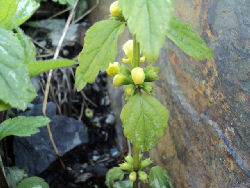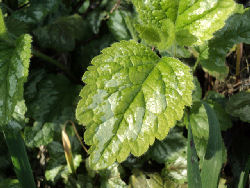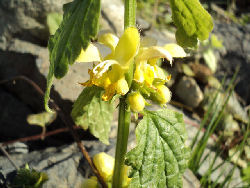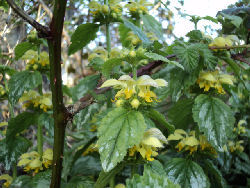Yellow Archangel - Lamium galeobdolon
Family: Lamiaceae - Mint Family PFAF
 |
 |
 |
 |
Description
Synonyms
- Lamiastrum galaebdolon (L.) Ehrend. & Polatschek [E-flora][PFAF][luontoportti][Cornell]
- Lamiastrum luteum [Cornell]
- Galeobdolon luteum. [PFAF][PWOBC][Cornell]
General "...growing to 0.3 m (1ft) by 1 m (3ft 3in) at a fast rate." [PFAF]
Lifecycle Perennial [PFAF][luontoportti]
Flowers The flowers are hermaphrodite (have both male and female organs) and are pollinated by Bees.[PFAF] "Corolla yellow with brownish markings..." [PWOBC] Flowers in whorls forming an interrupted spike. [luontoportti] "Flowers are small, yellow and tubular". [Kingcounty]
Fruits 4-parted schizocarp.[luontoportti]
Leaves "...in a common horticultural variant with a whitish or silvery." [PWOBC] "...underside often dark violet, with toothed margin." [luontoportti] "...sharply toothed and shiny..." [Cornell] Hairy. Opposite. [Kingcounty]
Stem Stems are square [Kingcounty]
Properties "Leaves have unpleasant odor when crushed." [Cornell]
Habitat Part-shade in moist soils. [E-flora] Woods and shady hedgerows[5, 31], usually on heavier soils. Sometimes becoming locally dominant, especially after coppicing[17]. [PFAF]
Range Europe, including Britain, from Sweden south and east to Spain and Iran. [PFAF] Escapee in Finland, wild in Estonia and the Karelian isthmus.[luontoportti] "...escaping in many western Washington counties..." [Kingcounty]
Status Exotic. [E-flora]
Notes "Lower British Columbia is being invaded by L. galeobdolon variation florentium." [EatTheWeeds] There are a number of closely related taxa which hybridize with L. galeobdolon and in some cases are not unequivocally accepted as distinct species but considered subspecies or varieties by many authors.[Wiki-1]
Food
- "I said Lamiastrum was edible, not great. That said, like many close relatives in the mint family the Golden Dead Nettle is used as a green when young. Shoots and leaves are eaten boiled or sauteed in butter." [EatTheWeeds] *"...the plant can be used in the same way as White Dead-nettle, Lamium album." [paulkirtley]
- Young shoots and flowers collected by a southern-swedish foraging company for consumption [Tardio MWEP]
- Young Leaves & Shoots: "Young leaves and shoots - cooked[183]."[PFAF][ARA] Raw. [paulkirtley]
- Young Flowering Tops: "Young flowering tips - cooked."[PFAF] Young flowering tips cooked [EMNMPV.8]
- Older Leaves: Can be steamed or lightly cooked and the leaves eaten as a green. The leaves can be added to soups at any stage in their growth. [paulkirtley]
Medicinal Uses
- Herb: "The herb is antispasmodic, astringent, diuretic, expectorant, styptic and vasoconstrictor[4]." [PFAF]
Phytochemistry
|
Alkaloids
Benzoxazinoids
Betaines
|
Iridoid Diglucoside
C9 Iridoid Glucoside [Yalcin, Kaya]
Monomeric Phenylpropanoids [Yalcin, Kaya]
6-Hydroxy blepharin (aerial parts) [Ency TCM V.3] |
Cultivation
"A very easily grown plant, it tolerates most soils and conditions[200]. It grows well in heavy clay soils[17], though it prefers a light calcareous soil[1]. Dislikes dry soils[31]. This species succeeds even in dense shade, growing well under trees[31, 200]. Once established, it can also succeed in drought conditions under the shade of trees, providing there is plenty of humus in the soil[190]. There are at least four sub-species, L. galeobdolon montanum is the form generally found wild in Britain and it is a triploid. L. galeobdolon luteum and L. galeobdolon flavidum are both diploids[187]. L. galeobdolon argentatum is the more rampant form, its clone 'Variegatum' is a commonly used ground cover plant for shady places[187]. Plants seem to be immune to the predations of rabbits[233]. A very invasive plant, sending out long prostrate shoots that root at intervals along the stems[31, 200]. Special Features: Attractive foliage, Naturalizing."[PFAF]
Maintenance: "Trim back to 6 to 8 inches after flowering to keep looking neat and promote healthy growth. Keep soil moist, especially during dry spells." [Cornell]
Groundcover: "A good ground cover plant, spreading rapidly by means of its rooting stems and succeeding even in dense shade. It is very vigorous, however, and can smother small plants[31, 197, 200]. It does very well in woodlands[K]." [PFAF]
Propagation
"Seed - usually self sows freely and should not require human intervention. When they are large enough to handle, prick the seedlings out into individual pots and plant them out in the summer. The seed can also be sown in situ as soon as it is ripe. Division in spring. Succeeds at almost any time in the growing season. Very easy, larger clumps can be replanted direct into their permanent positions, though it is best to pot up smaller clumps and grow them on in a cold frame until they are rooting well. Plant them out in the spring."[PFAF] "Propagate by seed, cuttings, division or separation. Make stem cuttings in late spring or early summer. Divide in fall or spring." [Cornell] "Because yellow archangel spreads readily by stem cuttings, it is very important to discard plant material in such a way as to prevent spreading." [Kingcounty] "Spreads via rhizomes and stolons." [ARA]
Lamium SP. - Dead nettle
Annual [perennial herb], glabrous to hairy. Stem: decumbent to erect; base generally branched. Leaf: petioled to sessile; blade generally ovate to round or reniform, entire to toothed. Inflorescence: terminal and axillary, each head-like, subtended by leaves. Flower: calyx 5-lobed, lobes ± equal, generally acuminate; corolla 2-lipped, upper lip hood-like, lower lip ± 3-lobed, lateral lobes < central; stamens 4, fertile, generally enclosed by upper lip, anthers generally hairy; style ± equally 2-lobed. Fruit: nutlets triangular in ×-section, truncate distally.
40 species: temperate Eurasia, northern Africa. (Latin: ancient name) [Wagstaff et al. 1998 Plant Syst Evol 209:265–274]
Unabridged references: [Bernström 1955 Hereditas 41:1–122]
Local Species;
- Lamium amplexicaule - common dead-nettle [E-flora]
- Lamium galeobdolon - yellow archangel [2] & Various minor sources [E-flora]
- Lamium purpureum - purple dead-nettle [E-flora]
Lamium Sp.; HARPAGOSIDE [DukePhyt]
White Deadnettle - Lamium album
Part used: aerial parts
Lamium album L. is a spreading perennial, common in Britain, found by roadsides and on rough ground in sunny and shady sites. Other species used: Culpeper lists white, yellow and red deadnettles. Yellow deadnettle Lamium galeobdolon, syn. Lamiastrum galeobdolon or Galeobdolon luteum (Alipieva 2003) is a perennial plant of woodlands (Stace 1991 ). It has yellow flowers and taller stems than the white deadnettle. Culpeper describes red deadnettle as an annual with pale, reddish flowers. This is probably Lamium purpureum L., which is a common weed.
The Galeopsis genus is closely related and some descriptions could be of common hemp-nettle, Galeopsis tetrahit L.[TWHT]
White Nettle Lamium album
- "Medicinal Parts: The medicinal parts are the flowers and leaves." [PDR]
- "Habitat: The plant is common in Europe and central and northern Asia." [PDR]
- "Production: White Nettle flower consists of the dried petal with attached stamens of Lamium album as well as its preparations" [PDR]
Phytochemicals:
- "Iridoide monoterpenes: including among others lamalbide, caryoptoside. alboside A and B" [PDR]
- "Triterpene saponins" [PDR]
- "Caffeic acid derivatives: including among others rosmaric acid, chlorogenic acid" [PDR]
- "Flavonoids: including among others kaempferol glycosides Mucilages" [PDR]
Effect
- "Because of the mucins and saponins the drug is expectorant. It is astringent because of the tannins." [PDR]
Dosage
- "Mode of Administration: Comminuted drug for infusions and other galenic preparations for internal applications, rinses, baths and moist compresses; occasionally used as a constituent of sedative teas and bronchial teas." [PDR]
- Preparation:
- "Infusion — Pour one cup of water over 1 gm drug, leave to draw for 5 minutes and strain." [PDR]
- "Extract for poultices — Scald 50 gm of flowers with 500 ml of water, draw for 5 minutes and strain." [PDR]
- "Daily Dosage: For internal use, the average daily dose is 3 gm drug. For external use, 5 gm drug is added to a bath." [PDR]
- "Infusion — Pour one cup of water over 1 gm drug, leave to draw for 5 minutes and strain." [PDR]
References
- [2]Personal observation
- Cornell Yellow Archangel http://www.gardening.cornell.edu/homegardening/sceneb75a.html, Accessed Oct 22, 2015
- DukePhyt http://sun.ars-grin.gov:8080/npgspub/xsql/duke/plantdisp.xsql?taxon=2004, Accessed Oct 22, 2015
- E-flora http://linnet.geog.ubc.ca/Atlas/Atlas.aspx?sciname=Lamium galeobdolon&redblue=Both&lifeform=7,
- USDA Lamiastrum galeobdolo, US Dept. of Agriculture, http://plants.usda.gov/core/profile?symbol=LAGA2
- EatTheWeeds http://www.eattheweeds.com/golden-dead-nettle/, Accessed Oct 22, 2015
- 10-Deoxymelittoside, an iridoid diglucoside, and other iridoids from lamiastrum galeobdolon, Armandodoriano Bianco, Pietro Passacantilli, Giuliana Righi, Marcello Nicoletti, Mauro Serafini, Phytochemistry (Impact Factor: 2.55). 07/1986; 25(8):1981-1983.
- Jepson - John M. Miller & Dieter H. Wilken, 2013. Lamium, in Jepson Flora Project (eds.) Jepson eFlora, http://ucjeps.berkeley.edu/cgi-bin/get_IJM.pl?tid=9449, accessed on Feb 19 2015
- Kingcounty Yellow archangel, http://www.kingcounty.gov/environment/animalsAndPlants/noxious-weeds/weed-identification/yellow-archangel.aspx, Accessed Oct 22, 2015
- luontoportti Yellow Archangel, http://www.luontoportti.com/suomi/en/kukkakasvit/yellow-archangel, Accessed Oct 22, 2015
- paulkirtley http://paulkirtley.co.uk/2011/yellow-archangel-lamiastrum-galeobdolon/, Accessed Oct 22, 2015
- PFAF http://www.pfaf.org/user/Plant.aspx?LatinName=Lamium galeobdolon, Plants for a future, Accessed December 31, 2014
- Wiki Wikipedia
- 1 Lamium galeobdolon https://en.wikipedia.org/wiki/Lamium_galeobdolon, Accessed Oct 22, 2015
- 2 Salidroside https://en.wikipedia.org/wiki/Salidroside, Accessed Oct 22, 2015
- Yalcin&Kaya Ethnobotany, Pharmacology and Phytochemistry of the Genus Lamium (Lamiaceae), Funda Nuray Yalcin, Duygu Kaya, FABAD J. Pharm. Sci., 31, 43-52, 2006